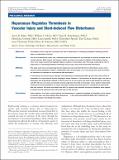Heparanase Regulates Thrombosis in Vascular Injury and Stent-Induced Flow Disturbance
Author(s)
Baker, Aaron B.; Kolachalama, Vijaya Bhasker; Golomb, Mordechai; Indolfi, Laura; Spruell, Christopher; Zcharia, Eyal; Vlodavsky, Israel; Edelman, Elazer R.; Gibson, William J., Ph. D. Massachusetts Institute of Technology; ... Show more Show less
DownloadBaker-2012-Heparanase Regulates.pdf (2.815Mb)
PUBLISHER_POLICY
Publisher Policy
Article is made available in accordance with the publisher's policy and may be subject to US copyright law. Please refer to the publisher's site for terms of use.
Terms of use
Metadata
Show full item recordAbstract
Objectives
The purpose of this study was to examine the role of heparanase in controlling thrombosis following vascular injury or endovascular stenting.
Background
The use of endovascular stents are a common clinical intervention for the treatment of arteries occluded due to vascular disease. Both heparin and heparan sulfate are known to be potent inhibitors of thrombosis. Heparanase is the major enzyme that degrades heparan sulfate in mammalian cells. This study examined the role of heparanase in controlling thrombosis following vascular injury and stent-induced flow disturbance.
Methods
This study used mice overexpressing human heparanase and examined the time to thrombosis using a laser-induced arterial thrombosis model in combination with vascular injury. An ex vivo system was used to examine the formation of thrombus to stent-induced flow disturbance.
Results
In the absence of vascular injury, wild type and heparanase overexpressing (HPA Tg) mice had similar times to thrombosis in a laser-induced arterial thrombosis model. However, in the presence of vascular injury, the time to thrombosis was dramatically reduced in HPA Tg mice. An ex vivo system was used to flow blood from wild type and HPA Tg mice over stents and stented arterial segments from both animal types. These studies demonstrate markedly increased thromboses on stents with blood isolated from HPA Tg mice in comparison to blood from wild type animals. We found that blood from HPA Tg animals had markedly increased thrombosis when applied to stented arterial segments from either wild type or HPA Tg mice.
Conclusions
Taken together, this study's results indicate that heparanase is a powerful mediator of thrombosis in the context of vascular injury and stent-induced flow disturbance.
Date issued
2012-04Department
Massachusetts Institute of Technology. Institute for Medical Engineering & Science; Harvard University--MIT Division of Health Sciences and TechnologyJournal
Journal of the American College of Cardiology
Publisher
Elsevier
Citation
Baker, Aaron B., William J. Gibson, Vijaya B. Kolachalama, Mordechai Golomb, Laura Indolfi, Christopher Spruell, Eyal Zcharia, Israel Vlodavsky, and Elazer R. Edelman. “Heparanase Regulates Thrombosis in Vascular Injury and Stent-Induced Flow Disturbance.” Journal of the American College of Cardiology 59, no. 17 (April 2012): 1551–1560. © 2012 American College of Cardiology Foundation
Version: Final published version
ISSN
07351097